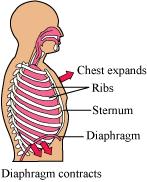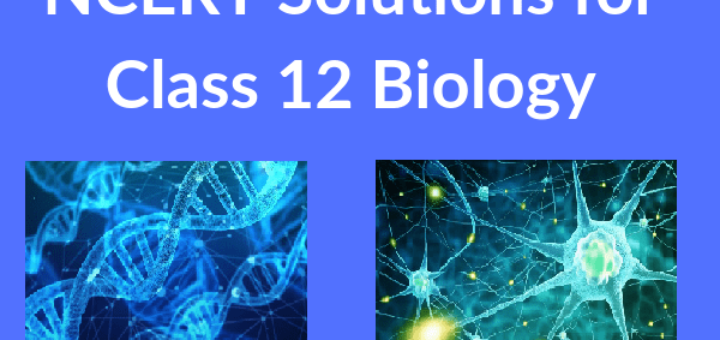Page No 277:
Question 1:
Define vital capacity. What is its significance?
Answer:
Vital capacity is the maximum volume of air that can be exhaled after a maximum inspiration. It is about 3.5 – 4.5 litres in the human body. It promotes the act of supplying fresh air and getting rid of foul air, thereby increasing the gaseous exchange between the tissues and the environment.
Question 2:
State the volume of air remaining in the lungs after a normal breathing.
Answer:
The volume of air remaining in the lungs after a normal expiration is known as functional residual capacity (FRC). It includes expiratory reserve volume (ERV) and residual volume (RV). ERV is the maximum volume of air that can be exhaled after a normal expiration. It is about 1000 mL to 1500 mL. RV is the volume of air remaining in the lungs after maximum expiration. It is about 1100 mL to 1500 mL.
∴FRC = ERV + RV
≅ 1500 + 1500
≅ 3000 mL
Functional residual capacity of the human lungs is about 2500 – 3000 mL.
Question 3:
Diffusion of gases occurs in the alveolar region only and not in the other parts of respiratory system. Why?
Answer:
Each alveolus is made up of highly-permeable and thin layers of squamous epithelial cells. Similarly, the blood capillaries have layers of squamous epithelial cells. Oxygen-rich air enters the body through the nose and reaches the alveoli. The deoxygenated (carbon dioxide-rich) blood from the body is brought to the heart by the veins. The heart pumps it to the lungs for oxygenation. The exchange of O2 and CO2 takes place between the blood capillaries surrounding the alveoli and the gases present in the alveoli.
Thus, the alveoli are the sites for gaseous exchange. The exchange of gases takes place by simple diffusion because of pressure or concentration differences. The barrier between the alveoli and the capillaries is thin and the diffusion of gases takes place from higher partial pressure to lower partial pressure. The venous blood that reaches the alveoli has lower partial pressure of O2 and higher partial pressure of CO2 as compared to alveolar air. Hence, oxygen diffuses into blood. Simultaneously, carbon dioxide diffuses out of blood and into the alveoli.
Question 4:
What are the major transport mechanisms for CO2? Explain.
Answer:
Plasma and red blood cells transport carbon dioxide. This is because they are readily soluble in water.
(1) Through plasma:
About 7% of CO2 is carried in a dissolved state through plasma. Carbon dioxide combines with water and forms carbonic acid.
Since the process of forming carbonic acid is slow, only a small amount of carbon dioxide is carried this way.
(2) Through RBCs:
About 20 – 25% of CO2 is transported by the red blood cells as carbaminohaemoglobin. Carbon dioxide binds to the amino groups on the polypeptide chains of haemoglobin and forms a compound known as carbaminohaemoglobin.
(3) Through sodium bicarbonate:
About 70% of carbon dioxide is transported as sodium bicarbonate. As CO2 diffuses into the blood plasma, a large part of it combines with water to form carbonic acid in the presence of the enzyme carbonic anhydrase. Carbonic anhydrase is a zinc enzyme that speeds up the formation of carbonic acid. This carbonic acid dissociates into bicarbonate (HCO3–) and hydrogen ions (H+).
Question 5:
What will be the pO2 and pCO2 in the atmospheric air compared to those in the alveolar air?
(i) pO2 lesser, pCO2 higher
(ii) pO2 higher, pCO2 lesser
(iii) pO2 higher, pCO2 higher
(iv) pO2 lesser, pCO2 lesser
Answer:
Answer: (ii) pO2 higher, pCO2 lesser
The partial pressure of oxygen in atmospheric air is higher than that of oxygen in alveolar air. In atmospheric air, pO2 is about 159 mm Hg. In alveolar air, it is about 104 mm Hg.
The partial pressure of carbon dioxide in atmospheric air is lesser than that of carbon dioxide in alveolar air. In atmospheric air, pCO2 is about 0.3 mmHg. In alveolar air, it is about 40 mm Hg.
Question 6:
Explain the process of inspiration under normal conditions.
Answer:
I
When air enters the lungs, the diaphragm contracts toward the abdominal cavity, thereby increasing the space in the thoracic cavity for accommodating the inhaled air.
The volume of the thoracic chamber in the anteroposterior axis increases with the simultaneous contraction of the external intercostal muscles. This causes the ribs and the sternum to move out, thereby increasing the volume of the thoracic chamber in the dorsoventral axis.
The overall increase in the thoracic volume leads to a similar increase in the pulmonary volume. Now, as a result of this increase, the intra-pulmonary pressure becomes lesser than the atmospheric pressure. This causes the air from outside the body to move into the lungs.
Question 7:
How is respiration regulated?
Answer:
The respiratory rhythm centre present in the medulla region of the brain is primarily responsible for the regulation of respiration. The pneumotaxic centre can alter the function performed by the respiratory rhythm centre by signalling to reduce the inspiration rate.
The chemosensitive region present near the respiratory centre is sensitive to carbon dioxide and hydrogen ions. This region then signals to change the rate of expiration for eliminating the compounds.
The receptors present in the carotid artery and aorta detect the levels of carbon dioxide and hydrogen ions in blood. As the level of carbon dioxide increases, the respiratory centre sends nerve impulses for the necessary changes.
Question 8:
What is the effect of pCO2 on oxygen transport?
Answer:
pCO2 plays an important role in the transportation of oxygen. At the alveolus, the low pCO2 and high pO2 favours the formation of haemoglobin. At the tissues, the high pCO2 and low pO2 favours the dissociation of oxygen from oxyhaemoglobin. Hence, the affinity of haemoglobin for oxygen is enhanced by the decrease of pCO2 in blood. Therefore, oxygen is transported in blood as oxyhaemoglobin and oxygen dissociates from it at the tissues.
Question 9:
What happens to the respiratory process in a man going up a hill?
Answer:
As altitude increases, the oxygen level in the atmosphere decreases. Therefore, as a man goes uphill, he gets less oxygen with each breath. This causes the amount of oxygen in the blood to decline. The respiratory rate increases in response to the decrease in the oxygen content of blood. Simultaneously, the rate of heart beat increases to increase the supply of oxygen to blood.
Question 10:
What is the site of gaseous exchange in an insect?
Answer:
In insects, gaseous exchange occurs through a network of tubes collectively known as the tracheal system. The small openings on the sides of an insect’s body are known as spiracles. Oxygen-rich air enters through the spiracles. The spiracles are connected to the network of tubes. From the spiracles, oxygen enters the tracheae. From here, oxygen diffuses into the cells of the body.
The movement of carbon dioxide follows the reverse path. The CO2 from the cells of the body first enters the tracheae and then leaves the body through the spiracles.
Question 11:
Define oxygen dissociation curve. Can you suggest any reason for its sigmoidal pattern?
Answer:
The oxygen dissociation curve is a graph showing the percentage saturation of oxyhaemoglobin at various partial pressures of oxygen.
The curve shows the equilibrium of oxyhaemoglobin and haemoglobin at various partial pressures.
In the lungs, the partial pressure of oxygen is high. Hence, haemoglobin binds to oxygen and forms oxyhaemoglobin.
Tissues have a low oxygen concentration. Therefore, at the tissues, oxyhaemoglobin releases oxygen to form haemoglobin.
The sigmoid shape of the dissociation curve is because of the binding of oxygen to haemoglobin. As the first oxygen molecule binds to haemoglobin, it increases the affinity for the second molecule of oxygen to bind. Subsequently, haemoglobin attracts more oxygen.
Question 12:
Have you heard about hypoxia? Try to gather information about it, and discuss with your friends.
Answer:
Hypoxia is a condition characterised by an inadequate or decreased supply of oxygen to the lungs. It is caused by several extrinsic factors such as reduction in pO2, inadequate oxygen, etc. The different types of hypoxia are discussed below.
Hypoxemic hypoxia
In this condition, there is a reduction in the oxygen content of blood as a result of the low partial pressure of oxygen in the arterial blood.
Anaemic hypoxia
In this condition, there is a reduction in the concentration of haemoglobin.
Stagnant or ischemic hypoxia
In this condition, there is a deficiency in the oxygen content of blood because of poor blood circulation. It occurs when a person is exposed to cold temperature for a prolonged period of time.
Histotoxic hypoxia
In this condition, tissues are unable to use oxygen. This occurs during carbon monoxide or cyanide poisoning.
Question 13:
Distinguish between
(a) IRV and ERV
(b) Inspiratory capacity and Expiratory capacity
(c) Vital capacity and Total lung capacity
Answer:
(a)
| Inspiratory reserve volume (IRV) | Expiratory reserve volume (ERV) |
| 1. It is the maximum volume of air that can be inhaled after a normal inspiration. 2. It is about 2500 – 3500 mL in the human lungs. | 1. It is the maximum volume of air that can be exhaled after a normal expiration. 2. It is about 1000 – 1100 mL in the human lungs. |
(b)
| Inspiratory capacity (IC) | Expiratory capacity (EC) |
| 1. It is the volume of air that can be inhaled after a normal expiration. 2. It includes tidal volume and inspiratory reserve volume. IC = TV + IRV | 1. It is the volume of air that can be exhaled after a normal inspiration. 2. It includes tidal volume and expiratory reserve volume. EC = TV + ERV |
(c)
| Vital capacity (VC) | Total lung capacity (TLC) |
| 1. It is the maximum volume of air that can be exhaled after a maximum inspiration. It includes IC and ERV. 2. It is about 4000 mL in the human lungs. | 1. It is the volume of air in the lungs after maximum inspiration. It includes IC, ERV, and residual volume. 2. It is about 5000 – 6000 mL in the human lungs. |
Question 14:
What is Tidal volume? Find out the Tidal volume (approximate value) for a healthy human in an hour.
Answer:
Tidal volume is the volume of air inspired or expired during normal respiration.
It is about 6000 to 8000 mL of air per minute.
The hourly tidal volume for a healthy human can be calculated as:
Tidal volume = 6000 to 8000 mL/minute
Tidal volume in an hour = 6000 to 8000 mL × (60 min)
= 3.6 × 105 mL to 4.8 × 105 mL
Therefore, the hourly tidal volume for a healthy human is approximately 3.6 × 105 mL to 4.8 × 105 mL.



